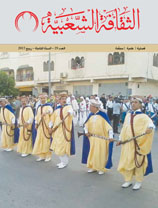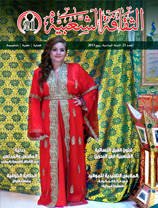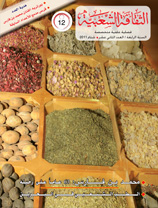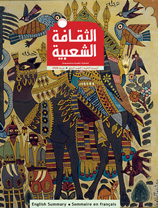The 1001 nights’ tradition in Italy
Issue 14

Francesca Maria Corrao (Italy)
With this quotation from the Qur’àn, al-Gahiz emphasizes the degree of consideration God has given to laughter, relating to life as the opposite to death; furthermore, he adds that smiling is a child first beautifull expression and makes his blood richer with joy and strength1.

Narration, in Shahrazade story has a function similar to the one of laughter, a message of the story is that death can be undone by life. Death is overcome through narration; in fact the act of narration saves Shahrazde from death. It follows that the opposite of discourse is death, and consequently discourse is indispensable for life. Survival is then an unrelenting struggle against silence. Narration is then, if I can use it as a metaphor, the suppression of silence, the suppression of oblivion; therefore I could say that the italian story-tellers, as Shahrazade, have kept alife the arabic imaginary in the italian folk litterature.

I will try here to examine how and what is left of this great heritage, and then I shall compare on the level of patterns and contents few stories which correspond in both arabic and italian traditions..
The italian scholars that have collected tales from the oral tradition, have always found and emphasized the presence of themes and motifs from The thousand and one night, stressing that the influence seems to be more evident in the southern italy tradition. As for example it is worth mentioning the collections of Giuseppe Pitré, Raffaele Lombardi Satriani and Italo Calvino2.
The arabic imaginary was spread in the west through the direct contact with the arab of Spain and Sicily, but also through the translations of classical arabic litterature. In the XIII/XIV centuries, the elevated litterary milieu was already aquainted with the oriental imagery, in particular with the stories of Kalila and Dimna, proverbs and anecdotes like the ones of Guhà.
These and other collections, together with biblical and Qur’ànic stories, have provided background for many non-sacred tales and anecdotes popular in the mediterranean area.
Among the most famous translations of the Middle ages it is worth mentioning the Panciatantra, that was translated into hebrew by Rabbi Joel in the XII cent., with the title Liber Kalilae et Dimnae, Directorium vitae humanae; it was the version that the admiral Eugenio, at the sicilian court of king William II (d.1189), used to revised a greek translation of the same work; a later spanish version by Giovanni da Capua (1493) was imitated by Agnolo Firenzuola in his Discorsi degli animali ragionanti fra loro, (1548), and by A. Doni in his Morale filosofia, (1570).
During the renaissance there has been an unbroken series of litterary "jest-books" containing anecdotes; due to the simplicity of its style, jests and anecdotes have influenced more the story-tellers, and I have found interesting to show the penetration of arabic lore in both oral and written traditions. For example a popular legend was rephrased by two famous authors G.C.Croce e di A. Banchieri, in a more sophisticated style in order to amuse an elegant public, and renamed Bertoldo Bertoldino e Cacasenno. A similar operation was made by the writer Giambattista Basile who collected neapolitan folktales in his Pentamerone. Giovanni Boccaccio is certainly the most famous in this gendre with his masterpieces The Decameron and The novels where it is possible to find many tales of arabic origins3.
The story-tellers, as I have already said, supported the translators in their work of diffusion, and made possible the survival of arabic lore in our oral tradition. Evidence is given by Italo Calvino in his collection Fiabe italiane where he wrote that the Thousand and one night were spread in Italy in the french version of Galland (XVII cent.), and as to prove it he quotes as an example the tale "The son of the king of France" heard from a peasant in a version closer to the french edition of Galland than to the italian translation made by Francesco Gabrieli4. Other interesting evidences are available in the sicilian tales collection by Giuseppe Pitré, where there is a conspicuous group of anecdotes attributed to a silly rogue called Giufà (or Giucà or Giucca), whose origins, according to the same Pitré, hark back to the arabic tradition.

The field of the present analysis is limited to two examples, I will compare the structure and few methaphores which correspond both in the italian Pentamerone and the arabic 1001 night, and then I will compare the arabic trickster Guhà with the sicilian silly rogue Giufà and the italians Chichibbio of Boccaccio and Bertoldo of Croce.
The structure of the Pentamerone, like the 1001 night, and the Maqamat by Hamadhani and Hariri, is organized on the basis of a frame tale which embodies others stories.
In the Pentamerone a black slave tricked a prince and took the place of his legitimate fiancee; as in the 1001 night the antagonist of the legitimate husband is a black slave. Another common place, striclty linked to the one of the adultery, is the blamefullness of women : in both works women are considered dangerous beings; therefore Shahrayar killed all of his wives in order not to be tricked. While Basile made his prince unaware of the trick, but he affirms that women are worse than snakes and cause calamities5.
In both works the two heroines use narration to transform their role from a passive to an active one, and bring to an happy end their unfair destiny. In the neapolitan story the fiancèe asks ten women to tell stories during five days, with the aim to reach a point where a last story, describing a similar situation, reveals the trick of the black slave. The daily narration of the women will rescue the poor fiancèe, like Shehrazad they don’t tell stories at night. In both stories the metaphorical strength of the rotation of the dark black of the night with the clear light of the day is extended, by analogy, to the dark skin of the lover opposite to the light skin of the legitimate spouse .
There is an identical symmetry with the 1001 night in the metaphorical field between the word-day-life in contrapposition to the field silence-night-death.

As for the stories of Guha there is no evidence, so far, to prove that they had been translated from arabic in the middle ages, and the first italian written collection of his anecdotes goes back to the last century. Though it is possible to recognize three of his anecdotes in the collection Bertoldo Bertoldino e Cacasenno, one in the Decameron, and nineteen attribuited to Giufà, or his stereotypes Sdirrammeddu and Firrazzanu, in the collections of Pitré.
The italian version of the arabic trickster of the VIII century6, is not very different from its original. Guha is always the silly-rogue that simbolizes the ability, innate in all of us, to find quick solution in front of any obstacle. This capacity, called metìs, is tipical of the fox and of the heroes of antiquity as Ulysses; the metìs enables to change a dramatic situation into a more favorable one. Guha is a common man wise and stupid at one time, who uses alternatively these two qualities to reach his aims or to save himself from danger.

Guha is a trickster and therefore he is a mediator halfway between polarities: stupid versus intelligent, rich versus poor, king versus paesant, wise versus fool. And it is in this role of mediator between oppositions that we first find him in the italian tradition. The three characters of Bertoldo, Betoldino and Cacasenno, father son and grandson, are all tricksters. They all stand in front of king Alboino in a similar position to the one of Guha in front of Abu Muslim, al-Mahdi, or later his turkish omologue in front of Timur Lank. In the italian version Alboino is the king of the Longobards (VI cent.) who ruled most of Italy. Croce used as framework to his story the legend of Salomon and Marcolpho, but Banchieri, and he himself, added new jests and anecdotes to the old version; and among those there are two stories that we find in both arabic and sicilian tradition. The first is as follows:
Cacasenno was in the castle of the king and coming out from the toilet he left the door open. A soldier, standing nearby, told him to pull the door closed, or the smell would come out. Cacasenno pulled the door off its hinges, went away to see the king carrying the door on his shoulders7;
and the second story :
The king ordered to his officer to go and find Bertoldino and bring him back to the court. The officer went and after sometime, convinced Bertoldino that the king had sent a horse so that he could come and visit.. Bertoldino mounted the horse backwards and when the officer tried to convince him that this was not the proper way to ride, Bertoldino refused to dismount and said: At least this way I will not have to see what is coming8.
The story of the Decameron is the one that narrates of Chichibbio who had roasted a crane and ate a thigh; when his sir asked about the missing thigh, he said that crane had only one and he showed the cranes sleeping sleeping on a thigh. When the sir cried and they put out their legs, Chichibbio affirmed that he had not cried at the first crane9 .
These few examples show that the distinctive feature of the trickster, who pushes situations to absurd extremes, is most visible when he himself appears as stupid. In the first anecdote he has neglected the current meaning of idiomatic expressions, therefore the blind fulfillment of the order ended up as a hilarious situation. He operates outside the boundaries of custom and law, like Hermes in the greek mithology10. Guha acts in any human field and therefore thank to his ever-changing caracter he can be wise in a story and fool in the following one, thief and then judge, deceiver and deceived. His action represents the overturning of established values, then he will always do the opposite one would expect.
With a witty remark he overturns the initial difficulty, he stimulates laughter putting together incompatible orders; and as a consequence of that a negative situation turns into a positive one. As it was evident in the two last anecdotes, the cunning poors Bertoldino, Guha and Chichibbio with a witty remark, stupid only in appearence, fooled their powerfull but silly sir.
The three heroes use narration to transform their role from a passive to an active one; and, to give a meaningfull example, as for Shahrazade narration saves them from death: Bertoldo was condamned to death and his last will was to choose the tree were he would have been hunged; at every tree he would find many excuses to look for anotherone, and the king understood his cunning trick and set him free. Also Guha was sentenced to death by al-Mahdy, and when he saw the sword warned the executioner: Do not hit my cupping-glass with the sword because I have already asked for a cupping! And the Mahdi laughed and forgave him.
Facing death they do not keep silent, no weep but words and laughter to affirm life.
There is an identical simmetry with the 1001 night in the metaphorical field between the word-laughter-life in contrapposition to the field silence-weep-death.







































































